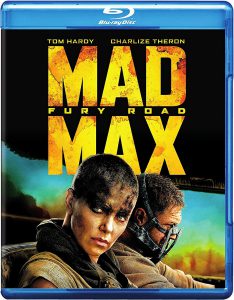George Miller returns to his most famous saga after a 30-year break and immediately shows he accumulated no rust in the interim. In some ways, “Mad Max: Fury Road” (2015) is a remake of “The Road Warrior,” as both films feel like wall-to-wall road-carnage action (although that’s not close to being the reality).
That 1981 film is the practical-effects version, whereas “Fury Road” blends practical effects with judicious computer effects, plus beautiful music and mood-setting colors in place of Eighties dust and grit. And most important of all, we get heartfelt character arcs amid what initially strikes me as a dystopia of sheer violence. For example, it’s heartwarming how Nicholas Hoult’s Nux switches sides to become a reliable ally of Furiosa (Charlize Theron) and Max (Tom Hardy, taking over for the aged-out Mel Gibson).
Starting with the epic conclusion
It’s both mildly frustrating and extremely smart that Miller tells this story out of order – especially in retrospect as we saw 2024’s “Furiosa,” which tells her backstory, was not nearly as successful at the box office. That said, her backstory adds so much depth to “Fury Road,” and so would Max’s backstory, “The Wasteland,” if it is ever made.

“Mad Max: Fury Road” (2015)
Director: George Miller
Writers: George Miller, Brendan McCarthy, Nick Lathouris
Stars: Tom Hardy, Charlize Theron, Nicholas Hoult
Over five days, RFMC looks at the five films of the “Mad Max” saga.
(“Fury Road” finds Max’s memories flashing to what appears to be a daughter he could not save. This isn’t a reference to the OG “Mad Max” trilogy, where his wife and young son are killed in the original. Kids factor into “Thunderdome,” but Max himself does not adopt one. As of this writing, it looks like “The Wasteland” won’t be made due to being too much of a financial risk, but nine years passed between the last two entries, so never say never.)
In breaks between the action set pieces, Miller efficiently builds lore and character motivations in ways he couldn’t quite do in the OG trilogy. For instance, one of the Citadel emperor’s slave wives – a batch of whom War Rig driver Furiosa is attempting to liberate under the guise of a normal shipment run – thinks about fleeing her rescuer and returning to her captor. Maybe it’s OK to be an honored, pampered Thing, rather than living in the unpredictable wilds.
As a running theme, “Fury Road” illustrates the “feminine” idea of community and the “masculine” idea of going it alone – represented by Furiosa and Max, respectively. Furiosa fairly quickly (for a world where no one can afford to trust strangers) trusts her new ally and tells him he’s welcome to join her and the freed slaves in the Land of Many Mothers (a.k.a. The Green Place, Furiosa’s home community as seen in “Furiosa.”). But he says he’s fine making his own way.

Well, in terms of survival, he certainly has a knack for it. Heck, maybe in this film with a touch of religion – all the Citadel warriors dream of Valhalla, and one of the wives prays “to anyone who will listen” – he’s some sort of Chosen One. He miraculously survives a lot of scrapes, including serving as a “blood bag” to the ailing Nux before a shake-up turns them into allies.
OK, you’re here for the action, aren’t you?
Despite all the world-building and character arcs, “Fury Road” is rightly known for its action. Certainly, it can’t be denied it’s the greatest road actioner of all time; even the most pedestrian stunt in this film beats the greatest stunt in the “Fast & Furious” saga.
Miller and his team construct a heavy-metal ballet (literally, an electric guitarist blasts tunes afront the Citadel marauders’ caravan, although wisely, Junkie XL’s score predominates in the mix). For example, the bad guys have pole-vault poles that they use to swing from their vehicles onto the War Rig. The revelation of these devices comes out of nowhere, but it’s amazing. It makes us want to see how the baddies will strategize, and we marvel at the resulting choreography.
“Fury Road” leans toward the stereotypical “masculine” type of movie. For example, Nux and one of the slave wives (Riley Keough) form a bond that comes even more out of the blue than the vault poles. And even though they are the two leads, both single and about the same age, there’s no sense of romance between Furiosa and Max.
And yet the stereotypical “feminine” sense of beautiful art predominates. For all the grime the road, Miller keeps Keough and the other wives looking pretty, and the director finds beauty in wastelands that are not merely uninhabited Australia, but post-apocalyptic Australia. Even when the dream of the Green Place is shattered, the resultant quagmire has a striking “Sin City”-esque muted color palette due to the fog.
“Mad Max: Fury Road” is one of the coolest movies ever made, but – unlike almost everyone else who has made a legacy sequel – Miller doesn’t forget his roots. Or rather, he’s deeply in touch with made his original films great, rather than merely dropping ’memberberries. (Indeed, all of the references are to unmade-at-the-time prequels “Furiosa” and “The Wasteland.”) He adds money to his passion for high-octane road action, rather than letting money replace his passion.
IMDb Top 250 trivia
- “Mad Max: Fury Road” ranks No. 183 on the list with an 8.1 rating.
- It’s the only “Mad Max” film on the chart. Up next in the ratings are “The Road Warrior” (7.6), “Furiosa” (7.5), “Mad Max” (6.8) and “Beyond Thunderdome” (6.2).
- “Inside Out” (No. 168, 8.1) is the only 2015 film that tops it.
“Mad Max” reviews:
Saturday, Jan. 4: “Mad Max” (1979)
Sunday, Jan. 5: “Mad Max 2: The Road Warrior” (1981)
Monday, Jan. 6: “Mad Max Beyond Thunderdome” (1985)
Tuesday, Jan. 7: “Furiosa: A Mad Max Saga” (2024)
Wednesday, Jan. 8: “Mad Max: Fury Road” (2015)

